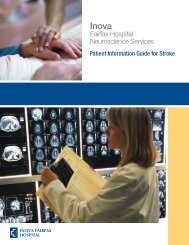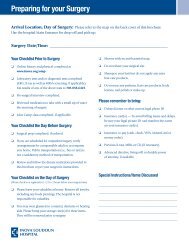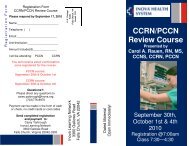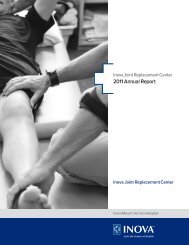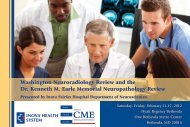Intracranial Hemorrhage - Inova Health System
Intracranial Hemorrhage - Inova Health System
Intracranial Hemorrhage - Inova Health System
You also want an ePaper? Increase the reach of your titles
YUMPU automatically turns print PDFs into web optimized ePapers that Google loves.
Disclosures<br />
<strong>Intracranial</strong> <strong>Hemorrhage</strong><br />
James G. Smirniotopoulos, M.D.<br />
Uniformed Services University<br />
Bethesda, MD<br />
No financial disclosures nor conflict of<br />
interest to report<br />
I’m from the Government …<br />
… and I here to help!<br />
Smirniotopoulos - USU - 2008<br />
Causes of <strong>Hemorrhage</strong><br />
Traumatic<br />
Aneurysms<br />
Neoplastic<br />
Infectious<br />
Vasculopathy<br />
Vascular Malformations<br />
Location of <strong>Hemorrhage</strong><br />
Extraaxial <strong>Hemorrhage</strong>: Epidural – Subdural - Subarachnoid<br />
Smirniotopoulos - USU - 2008<br />
Smirniotopoulos - USU - 2008<br />
What is <strong>Hemorrhage</strong>?<br />
Appearance of <strong>Hemorrhage</strong><br />
Extravasation of RBCs<br />
– Can be microscopic … microbleeds?<br />
Punctate or Petechial<br />
– Cortical Contusion, Shearing Injury<br />
– Reperfusion Injury/Hemorrhagic Infarction<br />
Coalescent<br />
– Venous Infarction<br />
Confluent Hematoma<br />
Space or Membrane Limited<br />
– EDH, SDH, SAH, Intraventricular<br />
Smirniotopoulos - USU - 2008<br />
Smirniotopoulos - USU - 2008<br />
1
Whole Blood = Cells + Plasma<br />
Whole Blood = Cells + Plasma<br />
35-45<br />
Hu<br />
=<br />
0-10<br />
Hu<br />
= +<br />
Serum<br />
~ 55-65%<br />
35-45<br />
Hu<br />
=<br />
0-10<br />
Hu<br />
= +<br />
Serum<br />
~ 55-65%<br />
60-90<br />
Hu<br />
RBC’s<br />
~ 35-45%<br />
60-90<br />
Hu<br />
RBC’s<br />
~ 35-45%<br />
Smirniotopoulos - USU - 2008<br />
Smirniotopoulos - USU - 2008<br />
MR Imaging of <strong>Hemorrhage</strong><br />
Blood Product:<br />
Oxyhemoglobin<br />
De-oxy Hgb<br />
T1W<br />
Iso<br />
Iso (1-3hr)<br />
T2W<br />
Iso<br />
Low (2hr)<br />
MR Imaging of <strong>Hemorrhage</strong><br />
Blood Product:<br />
T1W<br />
T2W<br />
Oxyhemoglobin I I<br />
De-oxy Hgb I (1-3hr)<br />
D (2hr)<br />
Met-Hgb (in cells)<br />
Met-Hgb (in soln.) Hi<br />
Hi (3-14hr)<br />
Dead RBCs and Thrombolysis<br />
Low<br />
Hi (hrs-wks)<br />
Met-Hgb (in cells) B (3-14hr)<br />
Met-Hgb (in soln.) B<br />
II * ID * BD * BB * DD<br />
D<br />
B (hrs-wks)<br />
Hemichromes<br />
Hemosiderin<br />
Low<br />
Low<br />
Smirniotopoulos - USU - 2008<br />
Low<br />
Lower<br />
Hemichromes D D<br />
Hemosiderin Smirniotopoulos D - USU - 2008<br />
D<br />
<strong>Intracranial</strong> <strong>Hemorrhage</strong><br />
Non-Penetrating Bullet<br />
Traumatic<br />
– Epidural<br />
– Subdural<br />
– Subarachnoid<br />
– Parenchyma<br />
Aneurysms<br />
Neoplastic<br />
Infectious<br />
Vasculopathy<br />
Vascular Malformations<br />
Smirniotopoulos - USU - 2008<br />
Smirniotopoulos - USU - 2008<br />
2
Non-Penetrating Bullet<br />
Non-Penetrating Bullet<br />
Smirniotopoulos - USU - 2008<br />
Smirniotopoulos - USU - 2008<br />
IED: Penetrating Injury<br />
Epidural Hematoma<br />
Usually acute clinical presentation<br />
Young patients, usually < 40<br />
– Dura firmly fixed in older pts.<br />
Usually unilateral<br />
Usually associated with Skull Fx<br />
<strong>Intracranial</strong> air, blood and metal fragments along wound track.<br />
Smirniotopoulos - USU - 2008<br />
Smirniotopoulos - USU - 2008<br />
Epidural Space<br />
•Scalp & Skull<br />
•Dura & Arachnoid<br />
•Pia and Brain<br />
•Ventricle and CSF<br />
Smirniotopoulos - USU - 2008<br />
EPIDURAL HEMATOMA<br />
Trauma -> > fracture & concussion<br />
Tearing/stripping of both layers<br />
from inner table<br />
Laceration of outer periosteal<br />
layer<br />
Laceration of meningeal vessels<br />
Inner (meningeal dura) intact<br />
Blood between naked bone and<br />
dura<br />
NORMAL arterial pressure<br />
continues to dissect<br />
periosteum from bone<br />
Smirniotopoulos - USU - 2008<br />
3
Epidural Hematoma<br />
2 y.o. with dilated pupil<br />
Smirniotopoulos - USU - 2008<br />
Midline Herniation: Subfalcial and Downward Transtentorial<br />
Smirniotopoulos - USU - 2008<br />
Epidural Hematoma<br />
Progressive EDH<br />
Smirniotopoulos - USU - 2008<br />
10 AM<br />
Smirniotopoulos - USU - 2008<br />
8 PM<br />
Subdural Hematoma<br />
Subdural Hematoma<br />
Acute to Subacute to Chronic Presentation<br />
May present at All ages<br />
– isolated SDH in infants and the elderly<br />
May be bilateral<br />
No particular association with fracture<br />
Smirniotopoulos - USU - 2008<br />
•Scalp & Skull<br />
•Dura<br />
•Arachnoid<br />
•Pia and Brain<br />
•Ventricle Smirniotopoulos - USU and - 2008<br />
CSF<br />
4
Bridging Veins<br />
Smirniotopoulos - USU - 2008<br />
Smirniotopoulos - USU - 2008<br />
Complex Subdural Hematoma:<br />
Adult<br />
SDH: Subfalcial Herniation<br />
1cm pineal shift, 3cm Right-to-Left shift and Subfalcial<br />
Herniation<br />
Smirniotopoulos - USU - 2008<br />
Smirniotopoulos - USU - 2008<br />
Subdural Hematoma Stages<br />
Hyperdense<br />
<br />
Isodense to Brain<br />
Chronic Interhemispheric Subdural<br />
Hypodense<br />
Normal Brain Density<br />
<br />
Acute Subacute Chronic<br />
< 3 days 3d – 2 wks > 2 wks<br />
Smirniotopoulos - USU - 2008<br />
Smirniotopoulos - USU - 2008<br />
5
Interhemispheric Subdural<br />
Subdural Hematoma<br />
Falx is too thick!<br />
Smirniotopoulos - USU - 2008<br />
Smirniotopoulos - USU - 2008<br />
Subarachnoid <strong>Hemorrhage</strong><br />
Subdural = Epi - Arachnoid<br />
Sup Sag Sinus<br />
Zig-Zag into Sulci<br />
Smirniotopoulos - USU - 2008<br />
Smirniotopoulos - USU - 2008<br />
Arachnoid Membrane<br />
Massive Contusions<br />
Smirniotopoulos - USU - 2008<br />
Courtesy of Alice B. Smith, UCSF<br />
Smirniotopoulos - USU - 2008<br />
6
Contre-Coup Coup Contusion<br />
Contre-Coup Coup Contusion<br />
Smirniotopoulos - USU - 2008<br />
Smirniotopoulos - USU - 2008<br />
Contre-Coup Coup Contusion<br />
Contusion<br />
Smirniotopoulos - USU - 2008<br />
Smirniotopoulos - USU - 2008<br />
Contusion<br />
Contusion<br />
Smirniotopoulos - USU - 2008<br />
Smirniotopoulos - USU - 2008<br />
7
Contusion<br />
Rough Anterior Skull Base<br />
Cranial nerves 2-12 intact … but the patient smells badly, not bad, but<br />
badly … Anosmia<br />
Smirniotopoulos - USU - 2008<br />
Smirniotopoulos - USU - 2008<br />
Cerebral Cortical Contusion<br />
Shearing Injury (DWI, DAI)<br />
•Crowns of Gyri<br />
•Linear or flame shape<br />
•NOT in depths of Sulci<br />
Smirniotopoulos - USU - 2008<br />
High velocity MVA<br />
Shaking injury in infants<br />
High frequency/steep impulse impact<br />
– Blast Injuries<br />
– High velocity bullets and fragments<br />
Small (< 15mm) and Deep (subcortical)<br />
May cause significant Sx – Coma<br />
May produce subtle (executive functioning)<br />
Smirniotopoulos - USU - 2008<br />
Coma: Lesions and Locations<br />
Shearing Lesions are<br />
small (
26 y.o. . man in Coma<br />
Deep Lesions … including<br />
thalamus … “shearing injury”<br />
…causing coma<br />
Deep Lesions … including<br />
thalamus … “shearing injury”<br />
…causing coma<br />
Corpus Callosum<br />
CT Scan<br />
Smirniotopoulos - USU - 2008<br />
MR Scan w/”blood sensitive” technique<br />
T2W<br />
Smirniotopoulos - USU - 2008<br />
SWI<br />
Corpus Callosum<br />
Corpus Callosum -> > Ventricle<br />
Dense, compact, white<br />
matter, bundles of<br />
axons<br />
Smirniotopoulos - USU - 2008<br />
Smirniotopoulos - USU - 2008<br />
Corpus Callosum and BG<br />
Unconscious Patient - CT<br />
Thanks to Pam Schaefer<br />
Smirniotopoulos - USU - 2008<br />
Smirniotopoulos - USU - 2008<br />
9
Diffuse Axonal Injury - FLAIR<br />
Deep Lesions … including<br />
thalamus … corpus callosum<br />
“shearing injury”<br />
Diffuse Axonal Injury - SWI<br />
Thanks to Pam Schaefer<br />
Smirniotopoulos - USU - 2008<br />
Thanks to Pam Schaefer<br />
Smirniotopoulos - USU - 2008<br />
Dorsolateral Brainstem<br />
30 y.o. man after motor cycle crash with facial<br />
swelling and facial fractures. Acute alteration in<br />
level of awareness.<br />
No sulci, no cisterns, low-attenuation both temporal lobes, brainstem (midbrain)<br />
hyperattenuating lesion.<br />
Smirniotopoulos - USU - 2008<br />
Smirniotopoulos - USU - 2008<br />
Diffuse cerebral swelling<br />
Anoxic Damage<br />
Loss of Autoregulation<br />
“Commotio<br />
Cerebri”<br />
Secondary herniation<br />
– Duret <strong>Hemorrhage</strong><br />
Duret <strong>Hemorrhage</strong>s<br />
Downward displaced<br />
brainstem<br />
Kinks and compresses<br />
perforators<br />
Hemorrhagic Infarction<br />
Smirniotopoulos - USU - 2008<br />
Smirniotopoulos - USU - 2008<br />
10
<strong>Intracranial</strong> <strong>Hemorrhage</strong><br />
Traumatic<br />
Aneurysms<br />
– Saccular, Fusiform, Mycotic<br />
– Subarachnoid hemorrhage, Siderosis<br />
Neoplastic<br />
Infectious<br />
Vasculopathy<br />
Vascular Malformations<br />
1980 2002<br />
Smirniotopoulos - USU - 2008<br />
Smirniotopoulos - USU - 2008<br />
Worst HA: Non-Contrast CT<br />
Subarachnoid <strong>Hemorrhage</strong><br />
Smirniotopoulos - USU - 2008<br />
Smirniotopoulos - USU - 2008<br />
Subarachnoid Clots<br />
Subarachnoid <strong>Hemorrhage</strong><br />
LP more sensitive than CT<br />
Trauma is most common cause for RBC’S S in CSF<br />
– Not seen as easily or as often on CT<br />
SAH on CT<br />
– Blood clot<br />
– Usually Aneurysm / AVM<br />
– Uncommon cause: neoplasm<br />
– Uncommon cause: spinal disease<br />
Morbidity<br />
– Vasospasm<br />
– Mass Effect (parenchymal hematoma)<br />
– Hydrocephalus<br />
Smirniotopoulos - USU - 2008<br />
Smirniotopoulos - USU - 2008<br />
11
Subarachnoid Space: Vasospasm<br />
The RBC’s release<br />
… ‘Evil Humors’<br />
Aneurysm and Rupture<br />
SPASM<br />
- Infarction<br />
HEMATOMA<br />
- Herniation, etc.<br />
Re-BLEEDING<br />
HYDROCEPHALUS<br />
Smirniotopoulos - USU - 2008<br />
Smirniotopoulos - USU - 2008<br />
Aneurysm and Rupture<br />
ANGIOGRAPHY<br />
– MRA & CTA:<br />
–Location of Aneurysm<br />
–Multiple (25% are)<br />
–Visualize "Neck“<br />
–Spasm ?<br />
–If (-)(<br />
) REPEAT in 2-32<br />
3 wks.<br />
Aneurysm and Rupture<br />
LOCATION of ANEURYSM<br />
–80-85% 85% Anterior Circulation<br />
–15-20% Posterior/Vertebral<br />
Smirniotopoulos - USU - 2008<br />
Smirniotopoulos - USU - 2008<br />
ACOMM Anuerysm<br />
Aneurysm<br />
Round (‘berry(<br />
berry’) ) shape<br />
Vessel bifurcation<br />
– natural weakness<br />
– exploited by high BP<br />
Common sites:<br />
– ACA < > ACOMM<br />
– MCA branches<br />
– Basilar Tip<br />
Smirniotopoulos - USU - 2008<br />
Smirniotopoulos - USU - 2008<br />
12
AP<br />
Angiography - Angiogram<br />
ICA Aneurysm<br />
Oblique<br />
Smirniotopoulos - USU - 2008<br />
Smirniotopoulos - USU - 2008<br />
Bilateral Carotid Aneurysms<br />
Pulsation Artifact<br />
Phase-encoding direction<br />
Smirniotopoulos - USU - 2008<br />
Smirniotopoulos - USU - 2008<br />
ICA Aneurysm<br />
Superficial Siderosis<br />
Smirniotopoulos - USU - 2008<br />
Smirniotopoulos - USU - 2008<br />
13
<strong>Intracranial</strong> <strong>Hemorrhage</strong><br />
Traumatic<br />
Aneurysms<br />
Neoplastic<br />
– Metastatic<br />
– Primary<br />
Infectious<br />
Vasculopathy<br />
Vascular Malformations<br />
<strong>Intracranial</strong> <strong>Hemorrhage</strong><br />
Traumatic<br />
Aneurysms<br />
Neoplastic<br />
– Metastatic<br />
Lung, Breast, Renal, Melanoma, Choriocarcinoma<br />
Infectious<br />
Vasculopathy<br />
Vascular Malformations<br />
Smirniotopoulos - USU - 2008<br />
Smirniotopoulos - USU - 2008<br />
Hemorrhagic Metastases<br />
Melanoma<br />
Metastasis<br />
Smirniotopoulos - USU - 2008<br />
Hemorrhagic<br />
Melanoma<br />
Metastasis<br />
Mets: Distributed by Blood<br />
Greatest Blood Flow<br />
– supratentorial<br />
– MCA territory<br />
Greatest Filtration<br />
– Gray-White Junction<br />
– Abrupt Change in Size & Number of<br />
Vessels<br />
Hematogenous Particles<br />
park at vessel branching<br />
points …<br />
Smirniotopoulos - USU - 2008<br />
Multifocal Nodular Lesions<br />
All Near Gray matter: cortex and basal ganglia<br />
Smirniotopoulos - USU - 2008 Smirniotopoulos - USU - 2008<br />
14
<strong>Intracranial</strong> <strong>Hemorrhage</strong><br />
Traumatic<br />
Aneurysms<br />
Neoplastic<br />
– Primary<br />
GBM, Oligodendroglioma, Pituitary, CNC, PCNSL<br />
Infectious<br />
Vasculopathy<br />
Vascular Malformations<br />
6/15<br />
7/22<br />
Smirniotopoulos - USU - 2008<br />
Courtesy Smirniotopoulos of R.D. Zimmerman, - USU - 2008<br />
NY<br />
Smirniotopoulos - USU - 2008 Smirniotopoulos - USU - 2008<br />
Oligodendroglioma<br />
Oligodendroglioma - Bleed<br />
Spontaneous <strong>Hemorrhage</strong> from fine vessels<br />
Smirniotopoulos - USU - 2008<br />
Smirniotopoulos - USU - 2008<br />
15
Pituitary MACRO-Adenoma<br />
Adenoma<br />
Smirniotopoulos - USU - 2008<br />
Smirniotopoulos - USU - 2008<br />
Pituitary Adenoma<br />
Adult Patient<br />
Microadenoma<br />
– < 10 mm<br />
– entirely within gland<br />
– Endocrine Sx.<br />
Prolactinoma <br />
Acromegaly<br />
Gigantism<br />
Cushing Disease<br />
Macroadenoma<br />
– > 10 mm<br />
– balloon sella<br />
– Visual Sx<br />
if >6 mm above sella<br />
Smirniotopoulos - USU - 2008<br />
bitemporal hemianopsia<br />
Pituitary Apoplexy<br />
Met Hemoglobin in<br />
Pituitary<br />
Macroadenoma<br />
Smirniotopoulos - USU - 2008<br />
Met Hemoglobin in<br />
Pituitary<br />
Macroadenoma<br />
Smirniotopoulos - USU - 2008<br />
Smirniotopoulos - USU - 2008<br />
16
David and Goliath<br />
Did Goliath have Gigantism and/or<br />
Acromegaly?<br />
He was a “Giant”<br />
He was an Angry Giant from HA and ICP<br />
Did he have a Macroadenoma?<br />
– David was able to sneak up to him<br />
bitemporal hemianopsia<br />
“Tunnel Vision”<br />
– One stone to the head killed him<br />
Pituitary Apoplexy<br />
<strong>Hemorrhage</strong> into Smirniotopoulos a macroadenoma<br />
- USU - 2008<br />
Neoplasms w/<strong>Hemorrhage</strong><br />
Glioblastoma<br />
Oligodendroglioma<br />
Pituitary Adenoma<br />
Central Neurocytoma<br />
Metastases<br />
– Lung, Breast, Renal, Melanoma, Thyroid,<br />
Choriocarcinoma<br />
Smirniotopoulos - USU - 2008<br />
<strong>Intracranial</strong> <strong>Hemorrhage</strong><br />
HSV Encephalitis<br />
Traumatic<br />
Aneurysms<br />
Neoplastic<br />
Infectious<br />
– Necrotizing Encephalitis (Herpes Simplex)<br />
– Angioinvasive Organism (aspergillus(<br />
aspergillus, mucor)<br />
– Mycotic Aneurysm<br />
Vasculopathy<br />
Vascular Malformations<br />
Smirniotopoulos - USU - 2008<br />
Smirniotopoulos - USU - 2008<br />
Hemorrhagic Necrosis and Atrophy<br />
Serpentine - Cortical Gyral<br />
Petechial<br />
<strong>Hemorrhage</strong>s<br />
Petechial<br />
<strong>Hemorrhage</strong>s<br />
Smirniotopoulos - USU - 2008<br />
Encephalitis<br />
Meningitis<br />
Smirniotopoulos - USU - 2008<br />
Meningo-Encephalitis<br />
17
HSV Encephalitis - FLAIR<br />
HSV Encephalitis – T1WGd+<br />
Smirniotopoulos - USU - 2008<br />
Smirniotopoulos - USU - 2008<br />
HSV Encephalitis – T2W<br />
HSV Encephalitis – T1WGd+<br />
Hemosiderin<br />
Smirniotopoulos - USU - 2008<br />
Smirniotopoulos - USU - 2008<br />
HSV Encephalitis – T1W<br />
Met Hemoglobin in<br />
Cortical Petechial<br />
<strong>Hemorrhage</strong>s<br />
Angioinvasive Infections<br />
Usually immune suppressed<br />
– AIDS<br />
– Chronic Diseases (Diabetes)<br />
Organism causes thrombosis, or breaks<br />
down vessel walls, causing hemorrhage<br />
Typical fungal organisms<br />
– Aspergillus: fumigatus (highly aerobic mold)<br />
– Zygomycetes: : e.g. Mucormycosis<br />
Smirniotopoulos - USU - 2008<br />
Smirniotopoulos - USU - 2008<br />
18
Mucormycosis BG Infarction<br />
with Secondary <strong>Hemorrhage</strong><br />
<strong>Intracranial</strong> <strong>Hemorrhage</strong><br />
Traumatic<br />
Aneurysms<br />
Neoplastic<br />
Infectious<br />
Vasculopathy<br />
– Hypertension, Amyloid, , Atherosclerosis,<br />
Dissection, Autoimmune, Infarction<br />
Vascular Malformations<br />
Smirniotopoulos - USU - 2008<br />
Smirniotopoulos - USU - 2008<br />
Hemorrhagic Embolic Infarction<br />
vs.<br />
Hemorrhagic Conversion<br />
vs.<br />
Venous Infarction<br />
CEREBROVASCULAR DISEASE:<br />
“Hemorrhagic Infarction”<br />
ARTERIAL ETIOLOGY<br />
– Embolic Occlusion (MCA)<br />
– Herniation (PCA, AChoA)<br />
VENOUS ETIOLOGY<br />
– Sinus Thrombosis (SSST)<br />
– Deep infarcts in strips, parallel falx<br />
CONVERSION in ISCHEMIC INFARCT<br />
– Large Infarcts (whole MCA)<br />
-Anticoagulation (incl. ASA and thrombolysis)<br />
Smirniotopoulos - USU - 2008<br />
Smirniotopoulos - USU - 2008<br />
Smirniotopoulos - USU - 2008 Smirniotopoulos - USU - 2008<br />
19
Reperfusion Injury<br />
Smirniotopoulos - USU - 2008 Smirniotopoulos - USU - 2008<br />
NCT<br />
Hemorrhagic Infarction<br />
ECT<br />
Hemorrhagic Infarction<br />
Hemorrhagic Infarction<br />
Smirniotopoulos - USU - 2008<br />
Smirniotopoulos - USU - 2008<br />
Herniation and PCA Infarction<br />
PCA Infarct Tentorial Herniation<br />
Superior Cerebellar a.<br />
Oculomotor nerve (CN3)<br />
Trochlear nerve (CN4)<br />
Posterior Cerebral aa.<br />
Temporal Lobe Herniation<br />
– Compresses CN3/4<br />
– Compresses PCA<br />
Slow flow allows bleeding<br />
Smirniotopoulos - USU - 2008<br />
Courtesy Mauricio Castillo, M.D. UNC<br />
Smirniotopoulos - USU - 2008<br />
20
PCA Infarct from Herniation<br />
Anterior Choroidal<br />
Artery Infarction<br />
Contusion vs. Hemorrhagic Infarction<br />
Anterior Choroidal<br />
Artery Infarction<br />
PCA Infarction<br />
Cortical Gray to<br />
Depth of Sulcus<br />
Smirniotopoulos - USU - 2008<br />
Smirniotopoulos - USU - 2008<br />
Plain T1W MR<br />
Hemorrhagic Infarction<br />
T1W<br />
PD<br />
Smirniotopoulos - USU - 2008<br />
Smirniotopoulos - USU - 2008<br />
Hemorrhagic Infarction<br />
Normal vs. Venous Outflow Obst.<br />
Deoxygenated blood<br />
Stagnates in capillary bed<br />
PD<br />
T2W<br />
Smirniotopoulos - USU - 2008<br />
Smirniotopoulos - USU - 2008<br />
21
MR Imaging of <strong>Hemorrhage</strong><br />
Blood Product:<br />
Oxyhemoglobin<br />
De-oxy Hgb<br />
T1W<br />
Iso<br />
Iso (1-3hr)<br />
T2W<br />
Iso<br />
Low (2hr)<br />
Hemorrhagic transformation<br />
Met-Hgb (in cells)<br />
Hi (3-14hr)<br />
Low<br />
Met-Hgb (in soln.) Hi<br />
Hi (hrs-wks)<br />
Hemichromes<br />
Hemosiderin<br />
Low<br />
Low<br />
Smirniotopoulos - USU - 2008<br />
Low<br />
Lower<br />
Initial CT<br />
Smirniotopoulos - USU - 2008<br />
24 hours later<br />
Herniation PCA compression & Bilateral Occipital Infarcts<br />
Carotid Thrombosis => MCA Clot<br />
ACA<br />
MCA<br />
This 53 yo man<br />
presented to the<br />
Emergency<br />
Department reporting<br />
a several hour<br />
history of left-sided<br />
hemi-body weakness<br />
medpix20366.jpg<br />
X<br />
MCA<br />
PCA<br />
Smirniotopoulos - USU - 2008<br />
Smirniotopoulos - USU - 2008<br />
medpix20367.jpg<br />
medpix20375.jpg<br />
ALWAYS compare w/ADC Map<br />
Repeat CT scans, two hours after admission<br />
DWI<br />
ADC Map<br />
Smirniotopoulos - USU - 2008<br />
Smirniotopoulos - USU - 2008<br />
22
Thrombotic Cerebral Infarction<br />
Venous Thrombosis and Infarction<br />
Two days after<br />
IA Thrombolysis<br />
Smirniotopoulos - USU - 2008<br />
Smirniotopoulos - USU - 2008<br />
CT @ 20º MR @ 0º<br />
Superior Sagittal Sinus Thrombosis<br />
CT<br />
T2W<br />
Deep hemorrhage into dead white-mater may spare cortex<br />
Smirniotopoulos - USU - 2008<br />
Smirniotopoulos - USU - 2008<br />
Superior Sagittal Sinus<br />
Thrombosis<br />
Sup. Sag. Sinus Thrombosis<br />
Dehydration<br />
Paraneoplastic Syndromes w/hypercoag<br />
Spinal Anesthesia<br />
Post-partum<br />
Smirniotopoulos - USU - 2008<br />
Smirniotopoulos - USU - 2008<br />
23
CEREBROVASCULAR DISEASE:<br />
HYPERTENSION<br />
Hypertensive Hematoma (<strong>Hemorrhage</strong>)<br />
Lacunar Infarction<br />
CEREBROVASCULAR DISEASE<br />
Arteriolar Sclerosis<br />
•Spontaneous Arteriolar Occlusion<br />
-lacunar infarcts<br />
•Spontaneous Rupture<br />
-”hypertensive hemorrhage”<br />
•Ectatic Elongation<br />
-Etat Crible<br />
Smirniotopoulos - USU - 2008<br />
Smirniotopoulos - USU - 2008<br />
ARTERIOLOSCLEROSIS<br />
Hyaline arteriolosclerosis<br />
Hyperplastic arteriolosclerosis<br />
"Lipohyalinosis"<br />
Smirniotopoulos - USU - 2008<br />
Smirniotopoulos - USU - 2008<br />
HYPERTENSIVE CVD<br />
Arteriolar occlusion - ischemia<br />
(Lacunae, Binswanger)<br />
Arteriolar rupture - hemorrhage<br />
(Hematoma-BG, Thal., etc.)<br />
Etat Crible (Dilated V-R) V<br />
(status cribrosus/cribalis)<br />
Smirniotopoulos - USU - 2008<br />
CEREBROVASCULAR DISEASE<br />
Arteriolar Sclerosis<br />
LACUNAE (Lacunar Infarcts)<br />
-Multiple<br />
-Small cavities (1-15 15 mm.)<br />
-Deep Gray and White:<br />
Putamen, , Thalamus, Internal<br />
Capsule, Pons<br />
Pure Motor Hemiplegia<br />
Arteriolosclerosis Smirniotopoulos - USU (HT)<br />
- 2008<br />
24
ARTERIOLOSCLEROSIS<br />
Old Lacunar Infarcts in GP<br />
Smirniotopoulos - USU - 2008<br />
Smirniotopoulos - USU - 2008<br />
HT HEMORRHAGE<br />
Putamen<br />
55%<br />
Cerebrum<br />
15%<br />
Thalamus<br />
10%<br />
Pons<br />
10%<br />
Cerebellum<br />
10%<br />
Smirniotopoulos - USU - 2008 Smirniotopoulos - USU - 2008<br />
HT BLEED<br />
Hypertensive <strong>Hemorrhage</strong><br />
Ateriolar Sclerosis<br />
– Hyaline arteriolosclerosis<br />
– Hyperplastic arteriolosclerosis<br />
– "Lipohyalinosis"<br />
Penetrating and non-anastomotic<br />
end-arteries and arterioles<br />
Deep Gray (Nuclear) Areas<br />
Smirniotopoulos - USU - 2008<br />
BP on presentation 185/105<br />
Courtesy Smirniotopoulos Doug Phillips, - USU - 2008<br />
UVA<br />
25
INTRA-CEREBRAL<br />
HEMORRHAGE<br />
Dense and Homogeneous<br />
Round/oval shape<br />
Basal ganglia/deep white<br />
Proportional mass effect<br />
Extension into ventricle<br />
Hypertensive <strong>Hemorrhage</strong><br />
Smirniotopoulos - USU - 2008<br />
Smirniotopoulos - USU - 2008<br />
Hypertensive <strong>Hemorrhage</strong><br />
Hypertensive Hematoma<br />
Usually single event<br />
HA, Pure motor hemiplegia, , etc.<br />
Expanding clot will displace white matter<br />
Local tissue pressure tamponade stops bleeding<br />
Treatment is often supportive<br />
– Herniation and deterioration prompt surgery<br />
Clot liquefies and is largely absorbed<br />
Hemosiderin ring<br />
Smirniotopoulos - USU - 2008<br />
Smirniotopoulos - USU - 2008<br />
Hypertensive Hematoma<br />
3 mo. p/Hypertensive <strong>Hemorrhage</strong><br />
Circumscribed Mass<br />
Pushing Margin<br />
Smirniotopoulos - USU - 2008<br />
Smirniotopoulos - USU - 2008<br />
26
3 mo. p/Hypertensive <strong>Hemorrhage</strong><br />
3 mo. p/Hypertensive <strong>Hemorrhage</strong><br />
Hemosiderin<br />
Smirniotopoulos - USU - 2008<br />
Smirniotopoulos - USU - 2008<br />
3 mo. p/Hypertensive <strong>Hemorrhage</strong><br />
81 y.o. . woman BP 200 mm Hg<br />
Hemosiderin<br />
Smirniotopoulos - USU - 2008<br />
Smirniotopoulos - USU - 2008<br />
Smirniotopoulos - USU - 2008 Smirniotopoulos - USU - 2008<br />
27
6 days p/Hypertensive Bleed<br />
Met Hemoglobin<br />
6 days p/Hypertensive Bleed<br />
Hemosiderin<br />
Smirniotopoulos - USU - 2008<br />
Smirniotopoulos - USU - 2008<br />
6 days p/Hypertensive Bleed<br />
Hypertensive <strong>Hemorrhage</strong><br />
Met Hemoglobin<br />
BP on presentation 210/110<br />
Smirniotopoulos - USU - 2008<br />
Courtesy Smirniotopoulos Doug Phillips, - USU - 2008<br />
UVA<br />
Hypertensive <strong>Hemorrhage</strong><br />
<strong>Hemorrhage</strong> into a mass<br />
Acute hemiplegia and confusion in a 68 year old man<br />
*<br />
Hypertensive “hit list”<br />
External Capsule<br />
Thalamus<br />
Dentate Nucleus<br />
Pons<br />
Lobar<br />
Courtesy Smirniotopoulos Doug Phillips, - USU - 2008<br />
UVA<br />
NOTE: Vasogenic Edema<br />
Courtesy Smirniotopoulos Doug Phillips, - USU - 2008<br />
UVA<br />
28
GBM<br />
Hypertensive Bleed vs. CCM<br />
Pt with only HA<br />
Minimal mass effect<br />
Pt acutely agitated<br />
Mass Effect<br />
Courtesy Smirniotopoulos Doug Phillips, - USU - 2008<br />
UVA<br />
Smirniotopoulos - USU - 2008<br />
CCM Has Complex Blood Products<br />
Amyloid Angiopathy<br />
Minimal mass effect, at presentation, blood products already complex<br />
with both methemoglobin (bright) and hemosiderin (dark)<br />
Smirniotopoulos - USU - 2008<br />
Smirniotopoulos - USU - 2008<br />
Arteriolosclerosis vs. Amyloid<br />
Mar 11 Mar 30<br />
Long standing HT<br />
Location:<br />
– Basal Ganglia,<br />
Thalamus, Brainstem<br />
Single Event<br />
+/- Hypertension<br />
Location:<br />
– Usually Lobar<br />
– Often Multifical<br />
Multiple Events<br />
– Can be bilateral<br />
Mar 13<br />
Smirniotopoulos - USU - 2008<br />
Smirniotopoulos - USU - 2008<br />
29
Smirniotopoulos - USU - 2008 Smirniotopoulos - USU - 2008<br />
Smirniotopoulos - USU - 2008 Smirniotopoulos - USU - 2008<br />
Extensive Amyloid, Acute Bleed<br />
MRI - T2*<br />
Smirniotopoulos - USU - 2008 Courtesy Smirniotopoulos Howard Rowley, - USU - 2008<br />
M.D.<br />
CT<br />
30
Cerebral amyloid angiopathy<br />
Extracellular deposition of amyloid in the walls of<br />
brain and meningeal blood vessels<br />
17 biochemically distinct forms of amyloid<br />
B-APP,<br />
Cystatin C, British protein involved<br />
Amyloid fibrils show B-Pleated sheet<br />
secondary structure<br />
Stains: Congo red, PAS, Thyoflavin S or T<br />
Cerebral amyloid angiopathy<br />
Involvement of small arteries and<br />
arterioles of cerebrum, cerebellum and<br />
leptomeninges<br />
Pathological changes<br />
– Fibrinoid necrosis<br />
– Microaneurysms<br />
Smirniotopoulos - USU - 2008<br />
Smirniotopoulos - USU - 2008<br />
Cerebral amyloid angiopathy<br />
Alzheimer disease<br />
Lobar hemorrhage<br />
– Sporadic<br />
– Familial<br />
Ischemic infarct in AD<br />
Ischemic infarct in non-demented<br />
patients<br />
Smirniotopoulos - USU - 2008<br />
Courtesy Vince Mathews, M.D.<br />
Smirniotopoulos - USU - 2008<br />
Microbleeds vs. Cavernous Malformations<br />
Courtesy Vince Mathews, M.D.<br />
Smirniotopoulos - USU - 2008<br />
Courtesy Vince Mathews, M.D.<br />
“microbleeds” are BLACK … cavernous malformations are complex Black & White<br />
Smirniotopoulos - USU - 2008<br />
31
Arteriolosclerosis vs. Amyloid<br />
<strong>Intracranial</strong> <strong>Hemorrhage</strong><br />
Long standing HT<br />
Location:<br />
– Basal Ganglia,<br />
Thalamus, Brainstem<br />
Single Event<br />
+/- Hypertension<br />
Location:<br />
– Usually Lobar<br />
Often multiple and<br />
progressive<br />
– Can be bilateral<br />
Traumatic<br />
Aneurysms<br />
Neoplastic<br />
Infectious<br />
Vasculopathy<br />
Vascular Malformations<br />
– Covered by Dr. Smith<br />
Smirniotopoulos - USU - 2008<br />
Smirniotopoulos - USU - 2008<br />
Summary<br />
Location of <strong>Hemorrhage</strong><br />
<strong>Hemorrhage</strong> has many causes<br />
<strong>Hemorrhage</strong> has many locations<br />
<strong>Hemorrhage</strong> has a variable appearance<br />
– Especially on MRI<br />
Extraaxial <strong>Hemorrhage</strong>: Epidural – Subdural - Subarachnoid<br />
Smirniotopoulos - USU - 2008<br />
Smirniotopoulos - USU - 2008<br />
Appearance of <strong>Hemorrhage</strong><br />
Smirniotopoulos - USU - 2008<br />
Thank You!<br />
<br />
Muito Obrigado<br />
EUXAPIT !<br />
Muchas<br />
Gracias<br />
Mahalo !<br />
Dank u wel !<br />
Go Raibh Maith Agat<br />
Merci Beaucoup<br />
Danke Smirniotopoulos Schön - USU - 2008<br />
!<br />
32




